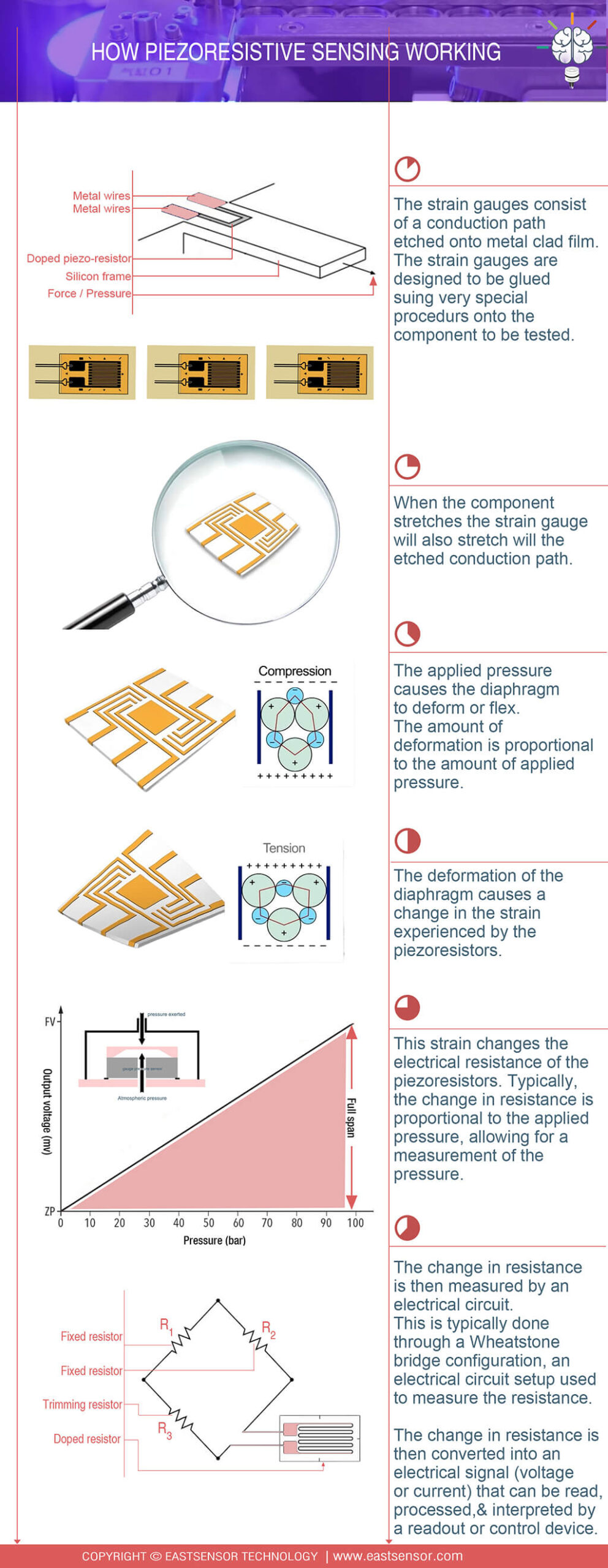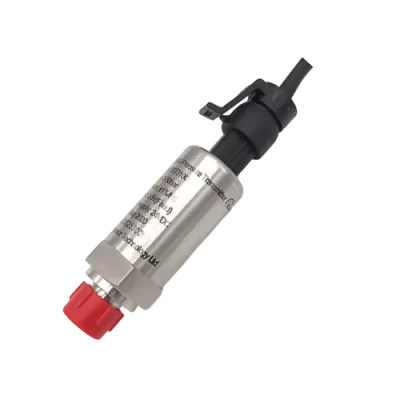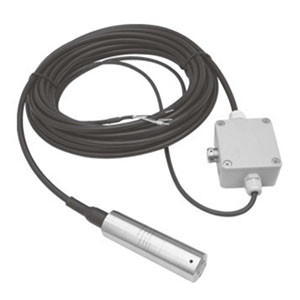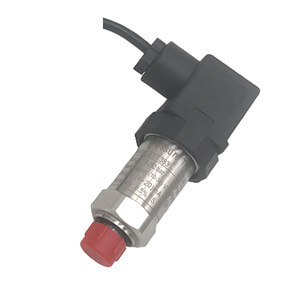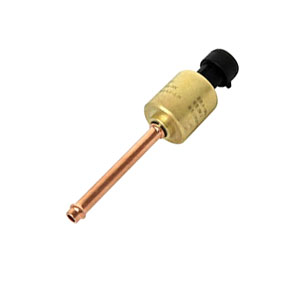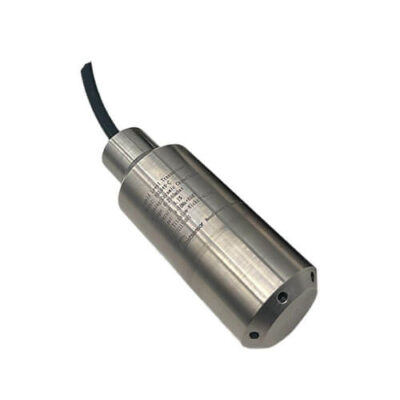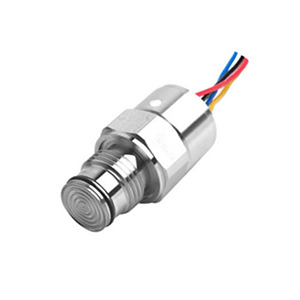Piezoresistive Sensing
Piezoresistive sensing is kind of technique that used to measure force, pressure, or mechanical stress by exploiting the piezoresistive effect, which is the change in electrical resistance of a material when it is subjected to mechanical deformation or strain.
The piezoresistive effect is the change in electrical resistivity of a material when it is subjected to mechanical stress or strain. This effect is observed in certain materials, such as semiconductors (e.g., silicon, germanium) and some metals and semiconductor ceramics. The change in resistivity is proportional to the applied stress or strain, allowing the measurement of force, pressure, or mechanical deformation by monitoring the change in electrical resistance.
The principle behind piezoresistive sensing is based on the fact that when a material is subjected to mechanical stress or strain, its atomic structure and electronic band structure are altered, leading to a change in its electrical resistivity. This change in resistivity is typically linear and proportional to the applied stress or strain within a certain range.
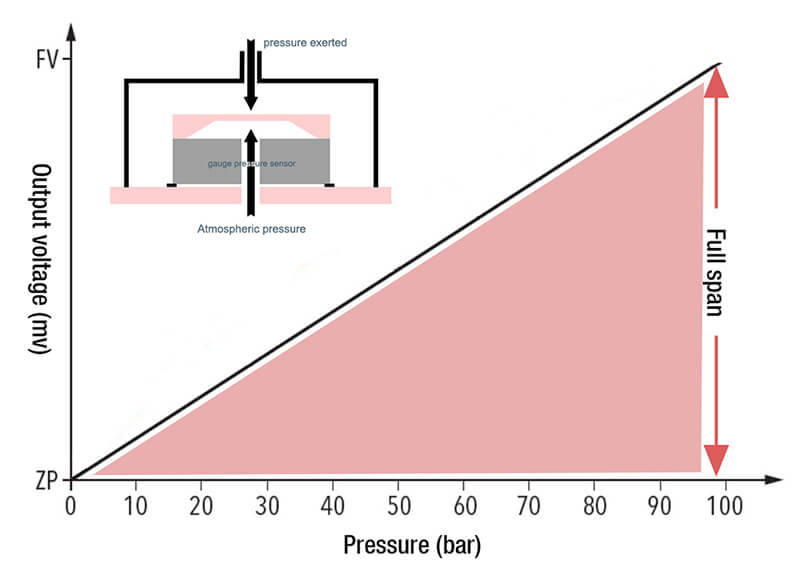
Piezoresistive sensor
In a piezoresistive sensor, a piezoresistive material is integrated into a sensing element, often in the form of a thin film or a bulk material with a specific geometry. When a force or pressure is applied to the sensing element, it deforms, causing a change in the resistance of the piezoresistive material. This change in resistance can be measured and converted into an electrical signal output that is proportional to the applied force or pressure.
Piezoresistive sensors are widely used in various applications, including:
- Pressure sensors: Used to measure pressure in various fields, such as automotive, industrial, and medical applications.
- Force sensors: Used to measure forces in load cells, strain gauges, and tactile sensors.
- Accelerometers: Used to measure acceleration and vibration in applications like inertial navigation, shock detection, and motion sensing.
- Tactile sensors: Used in robotics and haptic interfaces to detect touch, pressure distribution, and surface texture.
In now days, the piezoresistive effect is often combined with other sensing principles, such as capacitive or piezoelectric sensing, to create more advanced and versatile sensor systems.
Click to check: 5 Pressure Sensor Working Principles You Need to Know
How Piezoresistive Pressure Sensors Work
Piezoresistive pressure sensors are a type of sensor that work through the piezoresistive effect, which is the change in resistance of a material when mechanical strain is applied. This effect is usually obtained with semiconductor materials such as silicon or germanium.
The basic structure of a piezoresistive pressure sensor includes a diaphragm and a resistor, or piezoresistor. When pressure is applied to the diaphragm, it deforms or flexes, causing a strain that changes the resistance of the piezoresistor.
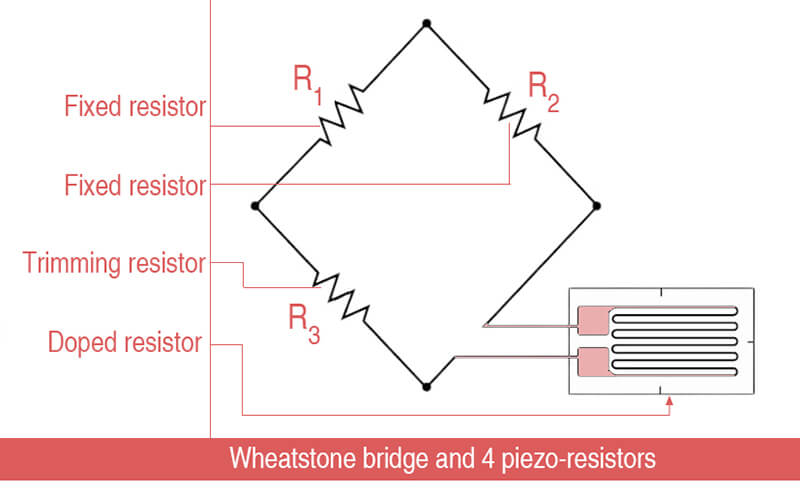
Steps breakdown
Here’s a step-by-step breakdown of how piezoresistive pressure sensors work:
- The sensor is exposed to a pressure input (such as air or liquid pressure). The pressure is typically applied to a thin silicon or metal diaphragm where the piezoresistors are located.
- The applied pressure causes the diaphragm to deform or flex. The amount of deformation is proportional to the amount of applied pressure.
- The deformation of the diaphragm causes a change in the strain experienced by the piezoresistors.
- This strain changes the electrical resistance of the piezoresistors. Typically, the change in resistance is proportional to the applied pressure, allowing for a measurement of the pressure.
- The change in resistance is then measured by an electrical circuit. This is typically done through a Wheatstone bridge configuration, an electrical circuit setup used to measure the resistance.
- The change in resistance is then converted into an electrical signal (voltage or current) that can be read, processed, and interpreted by a readout or control device.
An example
Imagine you have a small, thin square of silicon, which is a semiconductor material. This square is called a piezoresistive sensing element. It’s designed to change its electrical resistance when it’s deformed or squeezed.
Now, let’s say we want to measure the pressure of a gas or liquid. We take this piezoresistive sensing element and carefully mount it on a thin, flexible metal diaphragm. This diaphragm acts like a drumhead – it can bulge or deflect when pressure is applied to it.
When there’s no pressure, the diaphragm and the piezoresistive sensing element are flat and unstressed. In this state, the sensing element has a specific resistance value, let’s say 1000 ohms.
But when we apply pressure to the diaphragm, it starts to bulge or deflect. This deformation causes the piezoresistive sensing element to be squeezed or stretched, changing its resistance value. The higher the pressure, the more the resistance changes.
For example, in a typical piezoresistive pressure sensor designed for automotive applications, the sensing element might have a resistance change of about 0.2 ohms for every 1 psi (pound per square inch) of pressure applied. So, if the pressure is 100 psi, the resistance would change from 1000 ohms to around 1020 ohms.
We can measure this resistance change using a simple electrical circuit and convert it into a 4-20mA current or 0-5v voltage or I2C digital signal that represents the pressure value.
Now, let’s talk about some specific technical specifications:
- Sensing Element Material: Silicon is commonly used for its excellent piezoresistive properties and compatibility with integrated circuit fabrication processes.
- Diaphragm Material: Stainless steel, silicon, or other materials with good mechanical properties and compatibility with the sensing element.
- Pressure Range: Piezoresistive sensors can be designed for various pressure ranges, from millibar (mbar) levels for low-pressure applications to thousands of psi for high-pressure applications.
- Sensitivity: Typically expressed as the resistance change per unit of pressure, e.g., 0.2 ohms/psi.
- Linearity: Most piezoresistive sensors have good linearity (linear resistance change with pressure) over a wide range, often better than 0.5% of full-scale output.
- Temperature Compensation: Integrated circuits or software algorithms are used to compensate for temperature effects on the sensing element and electronics.
| Material | Piezoresistive Coefficient | Temperature Stability | Chemical Resistance | Size Compatibility | Cost |
|---|---|---|---|---|---|
| Silicon | High (up to 200x) | Low to Medium | Medium | Excellent | Moderate to High |
| Metal Foil | Low | High | High | Good | Low to Moderate |
| Ceramic | Medium | High | High | Good | Moderate |
| Polymer (e.g., PVDF) | Medium to Low | Medium | Variable | Excellent | Low to Moderate |
The most common types of piezoresistive sensing
Silicon Piezo-Resistive (Diffused) | The Epitome of Sensitivity and Speed
Silicon piezo-resistive pressure sensors harness the power of the piezo-resistive effect, where the electrical resistance of certain materials changes in response to mechanical stress or pressure. These sensors feature a silicon-based sensing element, with piezo-resistors carefully diffused into the substrate. By arranging these piezo-resistors in a Wheatstone bridge configuration, these sensors can precisely detect and measure the pressure-induced resistance changes. What sets silicon piezo-resistive sensors apart is their exceptional sensitivity, remarkable accuracy, and lightning-fast response times, often reaching the microsecond range. These capabilities make them indispensable in a wide array of applications, from industrial process control and medical equipment to automotive systems.
Ceramic Piezo-Resistive (Thick-Film) Pressure Sensors: Rugged and Versatile
Ceramic piezo-resistive pressure sensors offer a unique approach to pressure measurement. Instead of relying on silicon, these sensors utilize a ceramic-based sensing element, typically a mixture of oxides, with a thick-film piezo-resistive layer deposited on top. This design allows for the creation of pressure sensors with an impressive range, from low pressures in the millibar range to high pressures in the hundreds of bars.
Ceramic piezo-resistive sensors are renowned for their exceptional robustness, exceptional temperature stability, and remarkable resistance to harsh environmental conditions. These attributes make them invaluable in industrial automation, process control, and automotive applications where durability and reliability are paramount.
Thin-Film Piezo-Resistive (Sputtering) Pressure Sensors: Miniaturized Precision
Thin film piezo resistive innovative devices leverage the sputtering deposition process to create a highly sensitive and compact sensing element, often just a few microns thick.
This thin-film approach allows for the fabrication of miniaturized pressure sensors with remarkable sensitivity and fast response times, making them ideal for integration into micro-electromechanical systems (MEMS) and other compact, high-performance applications.
From medical diagnostics and industrial process control to consumer electronics, thin-film piezo-resistive pressure sensors are redefining the possibilities of pressure measurement.
Comparison among different piezo-resistive sensing
| Silicon Piezo-resistive | Ceramic Piezo-resistive | Thin-film Piezo-resistive | |
|---|---|---|---|
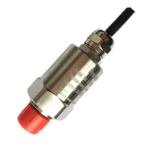 | 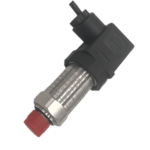 |
||
| Click to product page | EST330S | EST3120 | EST380 |
| Datasheet | Download | Download | Download |
| Principle | Piezo-resistive effect | Piezo-resistive effect | Piezo-resistive effect |
| Fabrication method | Diffused Silicon (single) | Thick-film Print | Thin-film spluttering |
| Sensing element | Made of silicon, where piezo-resistors are diffused into the silicon substrate. | Made of a ceramic material, typically a mixture of oxides, onto which a thick-film piezo-resistive layer is deposited. | fabricated using a sputtering deposition process, where a thin layer of piezo-resistive material is deposited onto a substrate, often silicon or ceramic. |
| MOC | SS316 | Ceramic Al2O3, dry type | Silicon nitride (Si3N4), ceramic |
| Min pressure to measure | 0-7kpa | 0-0.05bar | 0-4bar |
| Max pressure to measure | 0-1000bar | 0-480bar | 0-2200bar |
| Filled fluid | Silicon Oil | None | None |
| Highlight features | • High sensitivity • High stability • Good linearity • Temperature compensation | • High temperature resistance • Good chemical resistance • Cost-effective for high volume production | • High sensitivity • Good stability over time • Suitable for high-pressure applications |
| Suitable industry | • Biomedical instruments • Precision industrial controls • Aerospace and defense | • Automotive (e.g., engine management systems) • HVAC systems • Industrial process control | • Aerospace • Oil and gas industry • High-precision industrial applications |

